Ancient Huizhou Cultural Tourism Area is located in Huangshan City, Anhui Province, bordering Huangshan Mountain to the north and Qiandao Lake to the south, covering an area of 9.5 square kilometers. As a national 5A-level tourist attraction, it perfectly and vividly presents "Huizhou Culture"—one of China's three major regional cultures—to the world by integrating ancient city life, ancestral hall culture, memorial archway culture, Huizhou merchant culture, village culture, and residential architecture culture. The scenic area boasts various ancient buildings, including 116 spatial forms in 4 categories and 3,358 individual buildings in 12 categories. Among them, 1,325 ancient dwellings have been protected through adoption, residency, and purchase programs.
History and Culture
Ancient Huizhou Cultural Tourism Area has a long history. In the 5th year of the Dali period of the Tang Dynasty (770 AD), the pattern of "one prefecture and six counties" in Huizhou began to take shape. In the 6th year of the Wude period of the Tang Dynasty (623 AD), buildings such as Zhongwang Street, Liujia Garden, and Taizi Pond were successively constructed in the area, gradually forming villages where clans lived together. From the Song and Yuan dynasties to the Ming and Qing dynasties, a large number of ancient buildings were built one after another, such as the Huanxiu Bridge (a five-arch stone bridge) in Chengkan during the Yuan Dynasty and the Jinzi Ancestral Hall in Qiankou built in the 10th year of the Zhengde period of Emperor Wuzong of the Ming Dynasty. The Ming and Qing dynasties were the period when most Huizhou ancient buildings in Huangshan, Anhui were constructed. In 1984, the Qiankou Ancient Residences began to focus on protecting Ming Dynasty buildings; in the same year, the former site of Chongyi School was renovated into the Tao Xingzhi Memorial Hall. Since then, the scenic area has continued to develop and improve, and in 2014, it was awarded the honorary title of "National AAAAA-Level Tourist Attraction."
Major Attractions
Huizhou Ancient City
Huizhou Ancient City, the seat of the former Huizhou Prefecture Government, is one of the four best-preserved ancient cities in China. The scenic area features clusters of ancient dwellings, ancient bridges, ancient pagodas, ancient streets, ancient alleys, ancient dams, and ancient memorial archways. It administers six attractions: the Xu Guo Stone Archway (known as the "Oriental Arc de Triomphe"), the Huizhou Prefecture Yamen (symbol of Huizhou Ancient City), Doushan Street (the "No. 1 Street in the South of the Yangtze River"), Yuliang Ancient Wharf (the source of Huizhou merchants), Huizhou Garden (the "Grand View Garden of Huizhou"), and the Tao Xingzhi Memorial Hall (a national patriotic education base).

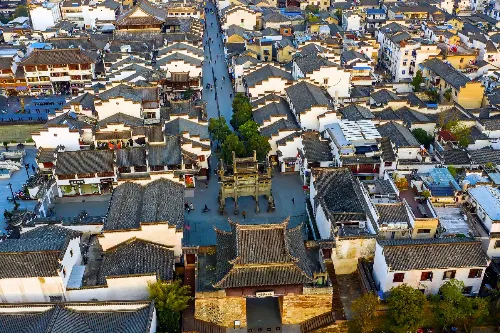
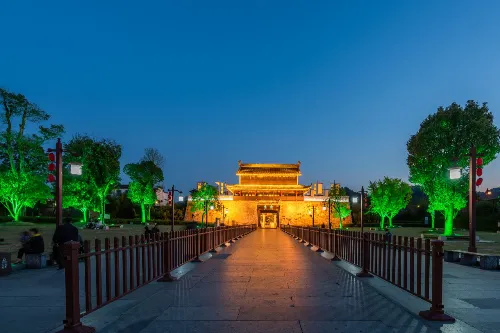
Memorial Archway Group & Bao's Garden
Located in Tangyue Village, She County, the scenic area is 10 kilometers away from the ancient city and 27 kilometers away from Tunxi, the seat of the municipal government. Here, you can find the ancient Tangyue Village, seven memorial archways, a male ancestral hall, a female ancestral hall, the Shixiao Ancestral Hall (inscribed with the names and filial deeds of the Bao clan's filial sons from past dynasties), and numerous commemorative buildings such as patriarchal halls, public welfare facilities, literary societies, academies, and grain depots. Complementing each other harmoniously, Bao's Garden and the Memorial Archway Group are based on the private gardens of Huizhou merchants and themed on Huizhou-style bonsai. They gather the essence of Huizhou bonsai art and represent works of various bonsai schools across China, known as the "Mother of Oriental Gardens."
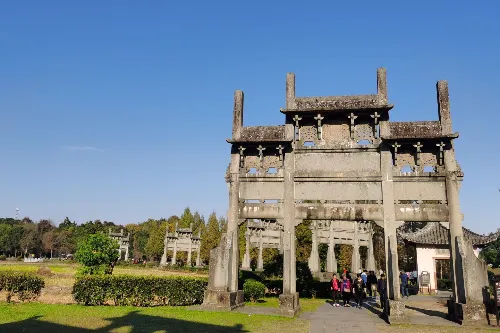

Tangmo Village
Known as "China's No. 1 Village with Water Gate Gardens," Tangmo Village was founded in the Tang Dynasty, developed in the Song and Yuan dynasties, and flourished in the Ming and Qing dynasties. Historically, it was praised as the "Model Village of the Tang Dynasty" for its prosperous economy and simple folk customs. The village is famous for the Tangan Garden, which imitates the scenery of West Lake. It features pavilions, terraces, towers, waterside pavilions, and long bridges, with the lake embankments lined with sandalwood and crape myrtle trees. The garden also includes scenic spots such as Three Pools Mirroring the Moon, Mid-Lake Pavilion, Bai Causeway, and Jade Belt Bridge, making it a miniature version of West Lake. The Mirror Pavilion is the center of the Small West Lake. Its four walls are built of marble, inlaid with calligraphy inscriptions by famous masters such as Su Shi, Zhu Xi, and Dong Qichang.
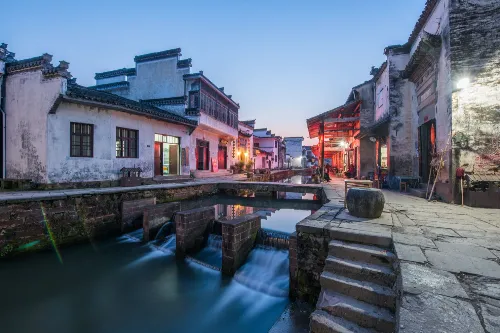

Qiankou Ancient Residences
Also known as Zixia Villa, Qiankou Ancient Residences are located at the southern foot of Zixia Peak in Qiankou Town, Huizhou District, Huangshan City, Anhui Province. As a complex of Huizhou-style buildings of Han nationality dwellings from the Ming Dynasty, it ingeniously displays various styles of ancient dwellings on a small hillside. Classified by architectural type, it includes caves, residences, small bridges, road pavilions, and memorial archways, spanning from the 8th year of the Hongzhi period of the Ming Dynasty to the mid-late Ming Dynasty in terms of time.
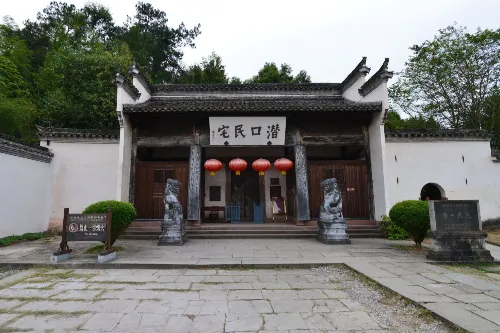

Chengkan Village
Hailed as a great miracle in the history of Chinese ancient architecture, Chengkan Village integrates natural landscapes with village layout based on the Bagua (Eight Trigrams) feng shui theory from the I Ching (Book of Changes). It interprets the ancient philosophers' theory of the interdependence and mutual restriction of all things in heaven and earth, and is known as "China's No. 1 Feng Shui Village." The village's long streets and short alleys are like a maze. Walking along the streets, the scenery changes with each step, making it feel like "wandering through a thousand alleys as if in a painting." Chengkan currently has 49 national key cultural relics under protection and has been listed as a "Famous Historical and Cultural Town of China," "Hometown of Chinese Ancient Architecture," "Hometown of Chinese National Treasures," and "China's Best Tourist Ancient Town."
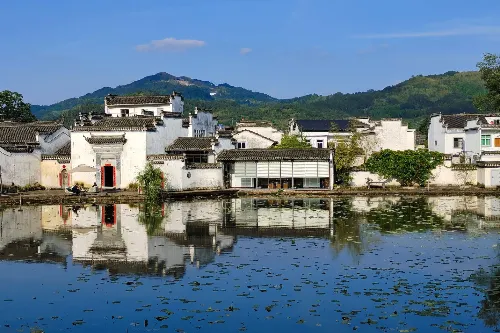
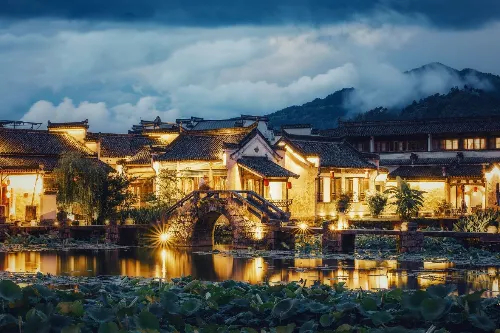
Tour Route
Huizhou She County → Jixi County → Yuliang Dam → Yuliang Ancient Town Old Street → Taibai's Ferry (where Li Bai asked for directions) → Yansi Wenfeng Pagoda → Qiankou Pagoda → Qiankou Ancient Residences → Chengkan Bagua Village → Baolun Pavilion → Tangmo Village → Tangyue Memorial Archway Group → Xin'an Stele Garden & Taibai Tower → Xu Guo Stone Archway.
Travel Tips
- It is recommended to arrange 2-3 days for the trip to fully appreciate the charm of Huizhou culture.
- You can choose to stay in a Huizhou-style homestay to experience the local lifestyle.
- There are many stone slab roads in the scenic area; comfortable shoes are recommended.
- If you are interested in Huizhou culture, hiring a tour guide can help you gain a deeper understanding of the historical and cultural connotations of the scenic area.
Notes
- Pay attention to safety and avoid falling into the water when traveling along the water streets in Tangmo Village.
- Do not touch or damage cultural relics when visiting ancient building areas.
- Take sun protection and mosquito repellent measures during summer trips.
- Some attractions are crowded with tourists; please take good care of your personal belongings.
Transportation
- By Air: Take a flight to Tunxi International Airport, then take a taxi to Huangshan City Bus Station, transfer to a coach to She County, and after arriving at She County Bus Station, take Bus No. 4 directly to the scenic area.
- By High-Speed Rail: Take the Beijing-Fuzhou High-Speed Rail to She County North Station, then take a bus to Huizhou Ancient City Scenic Area.
- By Car: Navigate directly to each attraction in Ancient Huizhou Cultural Tourism Area; there are parking lots around the scenic area.
Opening Hours
Huizhou Ancient City: 8:00 - 16:30; Night Tour: 19:00 - 21:30.
Memorial Archway Group: 7:00 - 18:00.
Chengkan Village: 8:00 - 17:00.
Tangmo Village: 8:00 - 17:30.
Qiankou Ancient Residences: 8:00 - 16:30.
Tickets
Five-Attraction Combined Ticket (Huizhou Ancient City, Memorial Archway Group, Tangmo Village, Chengkan Village, Qiankou Ancient Residences): 220 RMB per person. Separate tickets for individual attractions are also available.
You can search for the official WeChat public account "古徽州文旅" to get the latest updates or purchase tickets online.
Online Booking
Click here to jump to the Trip.com ticketing platform for ticket purchase.


